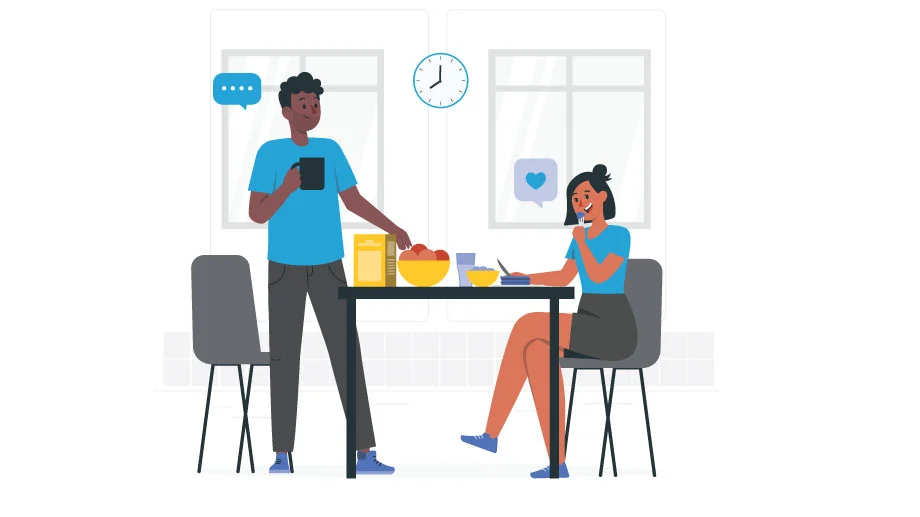In the ever-evolving landscape of labor laws, staying compliant with regulations is a pressing concern for field services businesses of all sizes. As of 2024, the California Lunch Break Law rules specific legal & compliance requirements for when and how breaks should be provided to employees. Advanced time tracking is one of the most common ways of simplifying compliance.

The California Lunch Break Law 2024 emphasizes the necessity for employers to offer timely and uninterrupted meal and rest periods throughout the workday. This blog delves into these regulations and explores how technology, particularly advanced time tracking applications, plays a crucial role in managing field service compliance effectively.
Decoding California Lunch Break Law Compliance Requirements
Under California law, employers are required to provide non-exempt employees a 30-minute meal break for every five hours worked and a 10-minute rest break for every four hours or major fraction thereof. The timing and execution of these breaks are critical:
- Lunch Breaks: Under California’s lunch break law, employees who work over 5 hours a day are eligible for an unpaid 30-minute meal break, which must start before they have worked more than 5 hours. If an employee is scheduled to work less than 6 hours in a day, they have the option to waive this meal break.
- Rest Breaks: Employees working over three and a half hours in a day are entitled to mandatory rest breaks. They must receive at least a 10-minute paid rest break for every four hours worked. Ideally, these breaks should occur near the middle of the work shift whenever feasible.
For roles that cannot leave the premises or must remain on-call, such as security guards or lone workers on night shift, employers must provide suitable facilities for eating and resting, and these breaks must be compensated.
To adhere to California labor laws regarding breaks, employers must:
- Fully relieve employees from all duties during their break,
- Allow employees to leave or engage in any activity of their choice during the break,
- Refrain from obstructing, discouraging, or directing employees’ activities during their break.
While employers are not obliged to enforce break taking, California Labor Code mandates that they must provide non-exempt employees with the opportunity to take breaks. Custom workflows and in-app notifications reminding employees to take breaks can help ensure compliance.
On-Site Lunch Break Requirements
Certain job roles, such as a lone security guard at a post or a single employee at a 24-hour convenience store, might necessitate taking meal breaks on-site. In these instances, where employees cannot be completely relieved of their duties, employers are required to offer a suitable eating area and pay employees during these breaks. Furthermore, if an employee’s shift starts or ends between 10 PM and 6 AM, the employer must also provide facilities to store, heat, or prepare hot food and drinks.
The Compliance Challenge
Ensuring adherence to the California meal break law (or lunch break laws in general) can be a significant challenge for employers, particularly those with large or decentralized workforces. Common pitfalls include:
- Scheduling Errors: Failing to schedule breaks within the required time frames.
- Recordkeeping Inaccuracies: Not maintaining accurate records of breaks, which can lead to disputes or penalties.
The consequences of non-compliance are not just legal battles but also potential penalties, including paying employees one hour of pay for each day a break was not properly provided.
How Technology Facilitates Compliance With California Lunch Break Law?
In this complex regulatory environment, time tracking becomes a savior. Modern time tracking software, such as those designed for field service management, can automate much of the heavy lifting associated with break compliance:
- Automated Alerts and Reminders: Systems can be set up to alert managers and employees when breaks are due, ensuring compliance even during hectic shifts.
Time tracking apps can be configured to trigger notifications, facilitating timely communication about schedule adjustments, task updates, visit reminders, and other critical information to the workforce. This comprehensive approach streamlines operations and enhances overall efficiency. - Accurate Record Keeping: Digital time tracking provides an immutable record of when breaks were taken, helping to avoid disputes and providing clear evidence in compliance audits.
This accuracy is essential as any discrepancies in break records can lead to disputes or penalties. By consolidating data in a cloud-based platform, businesses ensure that all records are accessible, up-to-date, and secure, minimizing the risk of compliance issues.
- Scheduling Optimization: Advanced algorithms can help schedule shifts and breaks efficiently, accommodating business needs while staying compliant.
Job scheduling software can significantly mitigate common scheduling errors by automatically filling empty shifts based on real-time attendance updates. It assigns shifts considering factors like staff availability, location, and specific job requirements. The software also ensures compliance with labor laws by effectively monitoring work hours, break times, and other legal stipulations.
Field operations often involve complex tracking and calculations such as shift differentials, overtime, and varying pay rates. Automating payroll not only streamlines these intricate calculations but also eliminates labor-intensive manual processes.
Ensuring that field employees take mandatory meal breaks can be particularly challenging in environments with shift differentials and other complexities. For instance, time tracking for construction is particularly complex. Here shifts can vary dramatically and projects often span different times and locations, tracking compliance with meal breaks becomes difficult.
Complex time tracking applications can handle these variables—tracking the start and end of shifts, adjusting overtime pay rates, and ensuring that meal breaks are taken as required by the standards set by California lunch break law regulations.
Other Benefits of a Well-Implemented Break Policy
- Legal Compliance: Robust break policies supported by effective technology ensure businesses meet legal standards.
- Boosts Morale and Productivity: Regular, uninterrupted breaks increase employee productivity and engagement.
- Technological Integration: Using technology to manage break policies demonstrates a commitment to fairness and labor rights.
- Enhances Reputation: This commitment improves the company’s image among both current and prospective employees.
Conclusion
As California continues to enforce strict labor laws, the importance of compliance cannot be understated. Businesses that leverage advanced technological solutions to manage meal and rest breaks are better positioned to avoid legal complications and foster a positive work environment.
In case of the California Lunch Break Law, simply adopting a complex time tracking solution that fits your business needs can ensure compliance. Such tools not only simplify the process, but also bring transparency and accuracy to the forefront of business operations, ensuring that both employees and employers can focus more on productivity and less on potential legalities.



